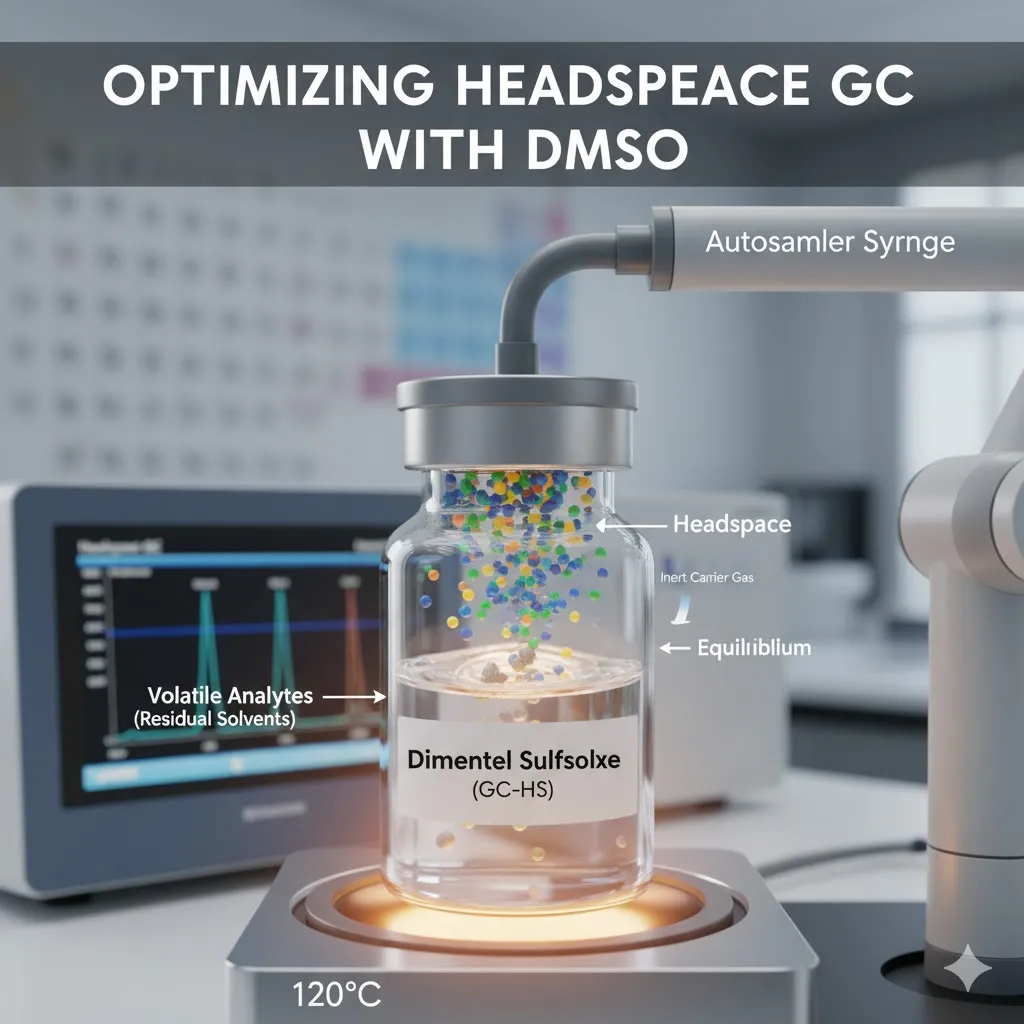A detailed explanationon Dimethyl Sulphoxide’s essence inachieving reliableGC-HS results in various analytical applications.
Headspace gas chromatography (GC-HS) is a valuable analytical method used to detect and measure volatile organic compounds (VOCs) in complex mixtures. Its simplicity, speed, and accuracy make it a preferred tool in pharmaceuticals, food testing, cosmetics, and chemical research. However, achieving precise and reproducible results heavily depends on one critical factor – the choice of solvent. Among the available solvents, dimethyl sulphoxide DMSO stands out as one of the most suitable options for headspace analysis.
Read ahead to understand more about DMSO.
What Is Dimethyl Sulphoxide?
Dimethyl sulphoxide, commonly referred to as DMSO, is a highly polar, aprotic solvent known for its exceptional solvating abilities. With its unique ability to dissolve both polar and non-polar substances, DMSO plays a critical role in sample preparation. It is widely used in laboratories and regulated industries due to its chemical stability, low volatility, and high boiling point.
- Chemical name: Dimethyl Sulphoxide
- CAS No: 67 68 5
- Appearance: Clear, colorless liquid
- Boiling point: 189°C
- Polarity: Highly polar
These physical and chemical characteristics make dimethyl sulphoxide DMSO the solvent of choice for headspace analysis in complex sample matrices.
Understanding Headspace Gas Chromatography (GC-HS)
Headspace gas chromatography is a specialized technique used to analyze volatile compounds without direct contact between the GC system and the non-volatile portion of the sample. In this method, the sample is sealed in a vial and heated. The volatile components from the sample migrate into the gas phase (the headspace), which is then introduced into the GC for separation and analysis.
This approach minimizes interference from non-volatile residues, reduces contamination risks, and speeds up the overall process.
Why Solvent Selection Matters in GC-HS
Choosing the right solvent for GC-HS is vital. The solvent must:
- Dissolve the sample thoroughly.
- Remain in the liquid phase under test conditions.
- Avoid interfering with the detection of volatile compounds.
- Be chemically inert under thermal and oxidative conditions.
Dimethyl sulphoxide DMSO, with its high boiling point and low volatility, fulfills all of these requirements, making it ideal for consistent and reliable headspace testing.
Advantages of Using Dimethyl Sulphoxide in GC-HS
Here’s why dimethyl sulphoxide DMSOis preferred over other solvents like water, N, N-dimethylformamide (DMF), and N, N-dimethylacetamide (DMAC):
1. High Boiling Point
DMSO remains stable under raised headspace temperatures, avoiding evaporation during sample heating. This prevents interference in chromatographic readings and ensures cleaner baselines.
2. Low Vapor Pressure
Low volatility ensures that dimethyl sulphoxide does not contribute to the gas phase during analysis. This results in more accurate measurement of the sample’s true volatile components.
3. Excellent Solubility
DMSO dissolves a wide range of sample types, both polar and non-polar. This leads to uniform sample distribution and ensures better repeatability.
4. Inertness and Stability
Under GC-HS conditions, dimethyl sulphoxide remains chemically stable. It does not degrade or react with analytes, preserving sample integrity.
5. Regulatory Acceptance
Dimethyl sulphoxide, listed under CAS No 67 68 5, is approved by pharmacopeias like USP and Ph. Eur. for use in headspace analysis of water-insoluble substances.
Practical Applications of Dimethyl Sulphoxide in GC-HS
Due to its properties, dimethyl sulphoxide finds wide application in the following areas:
- Pharmaceuticals: Residual solvent testing in active pharmaceutical ingredients (APIs) and drug formulations.
- Forensics: Detection of alcohols and volatile compounds in blood and biological samples.
- Polymers & Plastics: Analyzing monomers and VOCs in plastic materials.
- Cosmetics: Evaluating fragrance profiles in perfumes and beauty products.
- Food & Beverages: Detecting flavor components and contaminants.
These industries depend on precise analytical results, and the reliability offered by dimethyl sulphoxide helps ensure data integrity and regulatory compliance.
Best Practices for Using DMSO in GC-HS
To obtain optimal performance when using dimethyl sulphoxide DMSO (CAS No 67 68 5) in GC-HS:
- Use only high-purity solvents to avoid trace-level interference.
- Maintain transfer line and injector temperatures between 125°C–150°C to avoid condensation and sample loss.
- Prepare samples in low to high concentration order to reduce carryover risk.
- Perform blank runs and use matrix-matched standards to confirm reliability.
- Dilute high-concentration samples to avoid ghost peaks and ensure reproducibility.
A proper technique combined with dimethyl sulphoxide helps eliminate analytical errors such as split peaks, tailing, or inconsistent retention times.
Summing it Up
For accurate, reproducible, and clean chromatographic results, dimethyl sulphoxide is a preferred choice for headspace testing. Its superior chemical and physical properties—combined with its regulatory acceptance—make it an essential tool in modern analytical chemistry. Whether in pharmaceuticals, food analysis, or polymer testing, DMSO (CAS No 67 68 5) delivers reliable results where it matters most.
Using the wrong solvent can compromise data quality, but selecting dimethyl sulphoxide helps eliminate many common GC-HS challenges such as carryover, baseline noise, and volatile interferences
Trusted Source for Dimethyl Sulphoxide – Lab Chemicals
When it comes to sourcing dimethyl sulphoxide DMSO (CAS No 67 68 5) for critical headspace testing, quality and consistency matter. Lab Chemicals provides laboratory-grade solvents that meet stringent purity standards required for analytical applications. Their DMSO is trusted by professionals in pharma, food, and research labs to support accurate GC-HS performance every time.
Choose Lab Chemicals for reliable solvents that ensure your headspace chromatography results are accurate, reproducible, and compliant.

